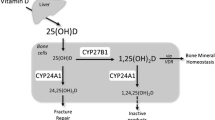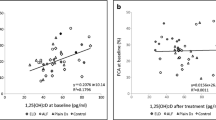Summary
Two fluoro analogs of 1α,25-dihydroxyvitamin D3 [1,25(OH)2D3], 24a-homo-24,24-difluoro-1α,25-dihydroxyvitamin D3 [24aF2-homo-1,25(OH)2D3], and 26,27-dimethyl-24,24-difluoro-1α,25-dihydroxyvitamin D3 [24F2-1,25(OH)2(Me)2D3] were examined for calcium (Ca)-regulating activity. The objective of the present study was to determine whether or not fluoro substitution at 24-position would alter activities of the original compounds, that is, 26,27-dimethyl 1α, 25-dihydroxyvitamin. D3[1,25(OH)2 (Me)2D3] and 24-homo-1α,25-dihydroxyvitaminD3[24homo-1,25(OH)2D3], respectively. The relative activities of 24aF2-homo-1,25(OH)2D3, 24F2-1,25(OH)2(Me)2D3, and 1,25(OH)2D3 in competing with 1,25(OH)2D3 for binding to chick intestinal cytosol receptor were 0.28:0.5:1.0. The relative potencies of the same series of compounds in competition for the vitamin D-deficient rat serum binding sites were 0.04:0.15:1. Bone-resorbing activities of two fluoro analogs in cultures of neonatal mouse parietal bones were more potent than that of 1,25(OH)2D3. Similar results were recognized in stimulating activities of osteoclast-like cell formation. Responses of two fluoro analogs to intestinal Ca absorption were similar to that of 1,25(OH)2D3. The potencies of 1,25(OH)2D3. and its fluoro analogs in bone Ca mobilization were the highest with 1,25(OH)2D3. followed by 24F2 1,25(OH)2(Me)2D3 and 24aF2-homo-1,25(OH)2D3, in that order. From these results and the data of Paulson et al. [24], fluoro substitution in 24-position of 1,25(OH)2D3. apparently does not alter their activities, hence, the fluoro substitution at 24-position of 1,25(OH)2D3. and the elongation of side chain of 1,25(OH)2D3. may not intensify Ca-regulating activity.
Similar content being viewed by others
References
DeLuca HF, Schones HK (1983) Vitamin D: recent advances. Annu Rev Biochem 52:411
Abe E, Miyaura C, Sakagami H, Takeda M, Konno K, Yamazaki T, Yoshiki S, Suda T (1981) Differentiation of mouse myeloid leukemia cells induced by 1α,25-dihydroxyvitamin D3. Proc Natl Acad Sci USA 78:4990–4994
Okamoto S, Tanaka Y, DeLuca HF, Kobayashi Y, Ikekawa N (1983) Biological activity of 24,24-difluoro-1,25-dihydroxyvitamin D3. Am J Physiol 244:E159-E163
Tanaka Y, DeLuca HF, Kobayashi Y, Ikekawa N (1984) 26,26,26,27,27,27-Hexafluoro-1,25-dihydroxyvitamin D3: a highly potent, long-lasting analog of 1,25-dihydroxyvitamin D3. Arch Biochem Biophys 229:348–354
Gill HS, Londowski JM, Corrodino RA, Zmsmeister AR, Kumar R (1988) The synthesis and biological activity of 25dihydroxy-26,27-dimethyl-vitamin D and 1,25-dihydroxy-26,27dimethyl-vitamin D: highly potent novel analogs of vitamin D. J Steroid Biochem 31:147–160
Eguchi T, Ikekawa N, Sumitani K, Kumegawa M, Higuchi S, Otomo S (1990) Effect on carbon lengthening at the side chain terminal of 1α,25-dihydroxyvitamin D3 for calcium regulating activity. Chem Pharm Bull (Tokyo) 38:1246–1249
Ostrem VK, Lau WF, Lee SH, Perlman K, Prahl J, Schones HK, DeLuca HF (1987) Induction of monocytic differentiation of HL-60 cells by 1,25-dihydroxyvitamin D analogs. J Biol Chem 262:14164–14171
Ostrem VK, Tanaka Y, Prahl J, DeLuca HF, Ikekawa N (1987) 24- and 26-homo-1,25-dihydroxyvitamin D3: preferential activity in inducing differentiation of human leukemia cells HL-60 in vitro. Proc Natl Acad Sci USA 84:2610–2614
Perlman K, Kutner A, Prahl J, Smith C, Inaba M, Schones HK, DeLuca HF (1990) 24-homologated 1,25-dihydroxyvitamin D3 compounds: separation of calcium and cell differentiation activities. Biochemistry 29:190–196
Miyahara T, Harada M, Miyata M, Sugure A, Ikemoto Y, Takamura T, Higuchi S, Otomo S, Kozuka H, Ikekawa N (1992) Calcium regulating activity of 26,27-dialkyl analogs of 1,25-dihydroxyvitamin D3. Calcif Tissue Int 51:218–223
Ikekawa N, Eguchi T, Hara N, Takatsuto S, Honda A, Mori Y, Otomo S (1987) 26,27-diethyl-1α,25-dihydroxyvitamin D3 and 24,24-difluoro-24-homo-1(x,25-dihydroxyvitamin D3: highly po tent inducer for differentiation of human leukemia cells HL-60. Chem Pharm Bull 35:4362–4365
Shigeno C, Yamamoto I, Dokoh S, Hino M, Aoki J, Yamada K, Morita R, Kaneyama M, Torizuka K (1985) Identification of 1,24(R)-dihydroxy-vitamin D3 like bone resorbing lipid in a patient with cancer-associated hypercalcemia. J Clin Endocrinol Metab 61:761–768
Takahashi N, Yamana H, Yoshiki S, Roodman GD, Munday GR, Jones ST, Boyde A, Suda T (1988) Osteoclast-like cell formation and its regulation by osteotropic hormones in mouse bone marrow cultures. Endocrinology 122:1373–1382
Burstone MS (1958) Histochemical demonstration of acid phosphatase with naphthol AS-phosphates. J Natl Cancer Inst 21:523–539
Suda T, DeLuca HF, Tanaka Y (1970) Biological activity of 25-hydroxy-ergocalciferol in rats. J Nutr 100:1049–1052
Connerty HV, Briggs AR (1966) Determination of serum calcium by means of orthocresolphthalein complexone. Am J Clin Pathol 45:290–296
Omdahl J, Holick MF, Suda T, Tanaka Y, DeLuca HF (1971) Biological activity of 1,25-dihydroxycholecalciferol. Biochemistry 10:2935–2940
Okumura H, Yamamuro T, Higuchi S, Harada M, Takamura T, Otomo S, Aihara H, Ikekawa N, Kobayashi (1990) 26,27-hexafluoro-1,25-dihydroxyvitamin D3(F6-1,25(OH)2D3) prevents osteoporosis induced by immobilization combined with ovariectomy in the rat. Bone Miner 9:101–109
Seino Y, Yamaoka K, Ishida M, Yabuuchi H, Ichikawa M, Ishige H, Yoshino H, Avioli LV (1982) Biochemical characterisation of 1,25-dihydroxyvitamin D receptor in chick embryonal duodenal cytosol. Calcif Tissue Int 34:265–269
Haddad JG, Chyu KJ (1971) Competitive protein-binding radioassay for 25-hydroxycholecalciferol. J Clin Endocrinol 33:992–995
Corradino RA, Ikekawa N, DeLuca HF (1981) Induction of calcium-binding protein in organ-cultured chick intestine by fluoro analogs of vitamin D3. Arch Biochem Biophys 208:273–277
Evans DB, Thavarajah M, Uskokovic MR, Kanis JA (1990) Increased potency of 1,25-dihydroxyvitamin D3 on human osteoblast-like cells following structural side-chain modification. Bone 11:439–443
Bouillon R, Allewaert K, Xiang DA, Tan BK, Baelen HV (1991) Vitamin D analogs with low affinity for the vitamin D binding protein: enhanced in vitro and decreased in vivo. J Bone Miner Res 6:1051–1057
Paulson SK, Perlman K, DeLuca HF, Stern PH (1990) 24- and 26-homo-1,25-dihydroxyvitamin D3 analogs potencies on in vitro bone resorption differ from those reported for cell differentiation. J Bone Miner Res 5:201–206
Author information
Authors and Affiliations
Rights and permissions
About this article
Cite this article
Harada, M., Miyahara, T., Miyata, M. et al. Calcium regulating activity of 24a-homo-24,24-difluoro-1α,25-dihydroxyvitamin D3 and 26,27-dimethyl-24,24-difluoro-1α,25-dihydroxyvitamin D3 . Calcif Tissue Int 53, 318–323 (1993). https://doi.org/10.1007/BF01351836
Received:
Revised:
Issue Date:
DOI: https://doi.org/10.1007/BF01351836




